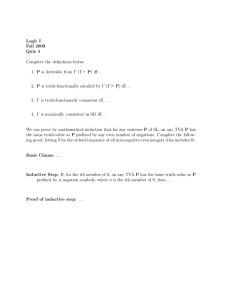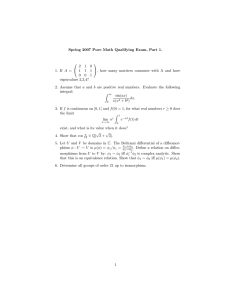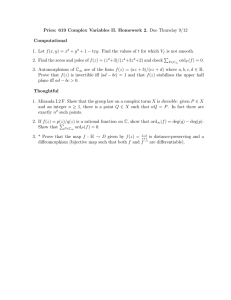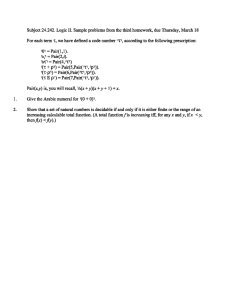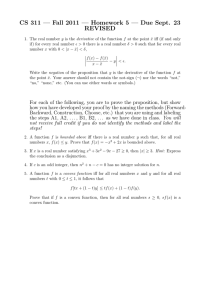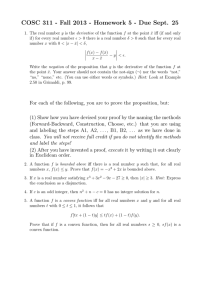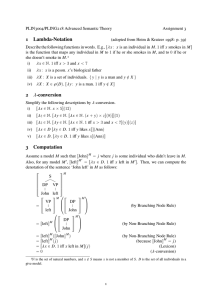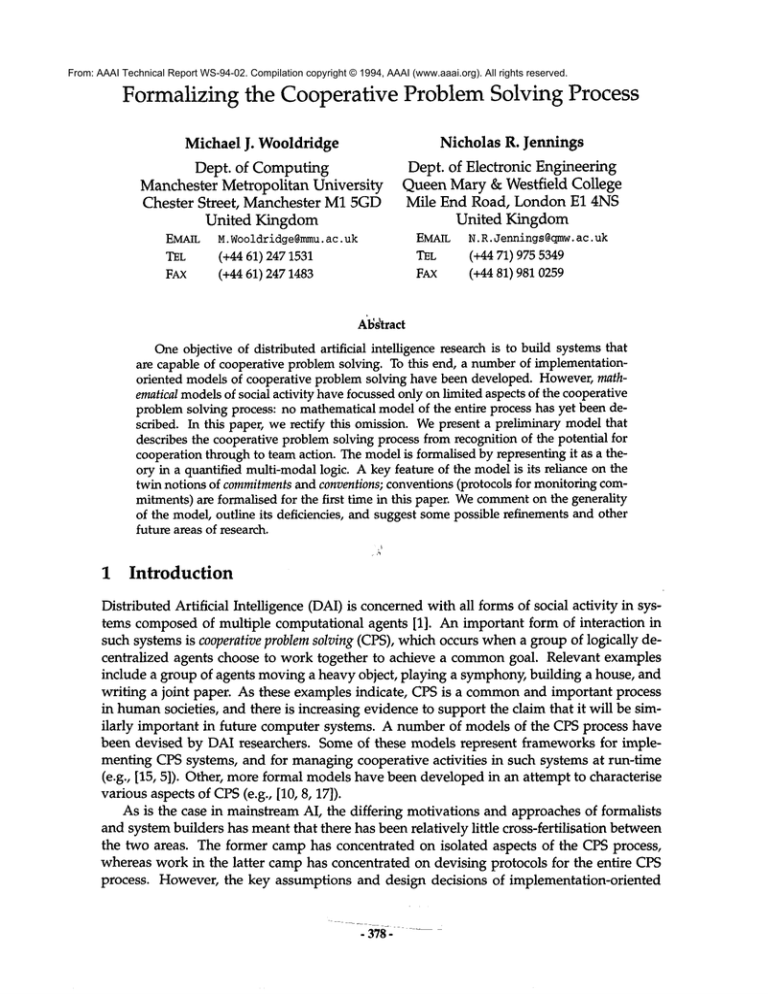
From: AAAI Technical Report WS-94-02. Compilation copyright © 1994, AAAI (www.aaai.org). All rights reserved.
Formalizing the Cooperative Problem Solving Process
Michael J. Wooldridge
Nicholas R. Jennings
Dept. of Electronic Engineering
Dept. of Computing
Queen Mary & Westfield College
Manchester Metropolitan University
Chester Street, Manchester M15GD Mile End Road, London E1 4NS
United Kingdom
United Kingdom
EMAIL
TEL
M. Wooldridge@mmu.
ac.uk
(+44 61) 247 1531
FAx
(+4461) 2471483
E~L~dL N.R.Jennings@qmw.
ac.uk
THE
(+4471)9755349
FAX
(+44 81) 981 0259
/%l~dtract
One objective of distributed artificial intelligence research is to build systems that
are capable of cooperative problem solving. To this end, a number of implementation-
oriented modelsof cooperative problemsolving have been developed.However,mathematicalmodelsof social activity havefocussedonly on limitedaspectsof the cooperative
problemsolving process: no mathematicalmodelof the entire process has yet beendescribed. In this paper, werectify this omission. Wepresent a preliminarymodelthat
describesthe cooperativeproblemsolving processfromrecognitionof the potential for
cooperationthroughto teamaction. Themodelis formalisedby representingit as a theory in a quantified multi-modal
logic. Akeyfeature of the modelis its reliance on the
twin notions of commitments
andconventions;conventions(protocols for monitoringcommitments)are formalisedfor the first time in this paper. Wecomment
on the generality
of the model,outline its deficiencies, and suggestsomepossible refinementsand other
future areasof research.
1
Introduction
Distributed Artificial Intelligence (DAI)is concernedwith all formsof social activity in systems composedof multiple computational agents [1]. Animportant form of interaction in
such systems is cooperativeproblemsolving (CPS), whichoccurs whena group of logically decentralized agents choose to work together to achieve a commongoal. Relevant examples
include a group of agents movinga heavy object, playing a symphon~building a house, and
writing a joint paper. As these examples indicate, CPSis a commonand important process
in humansocieties, and there is increasing evidenceto support the claim that it will be similarly important in future computer systems. A numberof models of the CPSprocess have
been devised by DAIresearchers. Someof these models represent frameworks for implementing CPSsystems, and for managingcooperative activities in such systems at run-time
(e.g., [15, 5]). Other, moreformal modelshave been developedin an attempt to characterise
various aspectsof CPS(e.g., [10, 8, 17]).
As is the case in mainstreamAI, the differing motivations and approaches of formalists
and systembuilders has meantthat there has been relatively little cross-fertilisation between
the two areas. The former camphas concentrated on isolated aspects of the CPSprocess,
whereas workin the latter camphas concentrated on devising protocols for the entire CPS
process. However, the key assumptions and design decisions of implementation-oriented
CPS models tend to be buried deep inside the associated software; this can makeit difficult
to extract general principles or results from implementations.
This paper goes some way to bridging the gap between theory and practice in DAI. In §4,
we develop a four-stage model of CPS, which we make precise by expressing it as a theory
in a quantified multi-modal logic. The development of this model was driven by an analysis
of CPSin both natural and artificial systems; the result is a theory that is accessible to both
formalists and system builders. For formalists, the model represents a preliminary attempt
to capture the properties of CPS in a mathematical framework. For system builders, the
model can serve as a top-level specification of a CPSsystem, which, we believe, can inform
the development of future DAI applications. The model deals with a number of issues that
have hitherto been neglected by DAItheorists; for example, it considers the process by which
an agent recognises the potential for cooperation, and begins to solicit assistance. Note that
although we have attempted to develop a model that deals with CPS from beginning to end,
we do not claim that our model is the final word on the subject; it would not be possible to
present, in such a short paper, a theory that dealt with all aspects of a process as complexas
CPS(see §5).
The remainder of this paper is structured as follows. The following section presents an
overview of the formal framework used to represent the model. In §3, the notions of commitments and conventions, which play a key role in our model, are discussed and subsequently
formalised; the model of CPS is then developed in §4. Someconclusions are presented in §5.
2
A Formal Framework
This section develops the formal framework in which the model of CPS will be expressed.
This framework is a new quantified multi-modal logic, which both draws upon and extends
the work described in [3, 13, 18]. Unfortunately, space restrictions prevent us relating the
logic to those developed by other researchers; details maybe found in the associated technical
report [19].
Informally, the operators of the language have the following meanings. The operator truo
is a logical constant for truth. (Bol i ¢p) and (Goal i 9) meanthat agent i has a belief, or goal
~0 respectively. The = operator is usual first-order equality. The ~ operator allows us to relate
agents to groups of agents; it has the expectefl set-theoretic interpretation, so (i e g) means
that the agent denoted by i is a memberof the group denoted by g. The (agts cz g) operator
means that the group denoted by g are precisely the agents required to perform the actions
in the action sequence denoted by ~z. The A operator is a path quantifier: Acp meansthat ¢p is
a path formula that is satisfied in all the futures that could arise from the current state 1. The
operators ~ (not) and v (or) have classical semantics, as does the universal quantifier V;
remaining classical connectives and existential quantifier are assumed to be introduced as
abbreviations, in the obvious way. (Happensc~) is a path formula that meansthat the action
happens next; cz; c~’ means the action a is immediately followed by (z’; ala’ means either c~
or a’ happennext; rp? is a test action, whichoccurs if rp is ’true’ in the current state; a* means
the action ¢~ iterated.
Syntax
Definition I The language contains the fo116"wing symbols: the propositional connectives --1
1There is a distinction made in the language between path and state formulae: state formulae are evaluated
with respect to the ’current state’ of the world, whereas path formulae are evaluated with respect to a course of
events. The well-formed formulae of the language are identified with the set of state formulae [6].
-379-
---
--
(ag-term
I
(ac-term
I
(gr-term)
:;=
::=
;:=
any element
any element
any element
(ac-exp)
of TermAg
(term) ::= any element of Term
of TermA¢
(pred-sym) ::= any element of Pred
of Termcr
(var) ::= any element of Var
::= (ac-term)
I (ac-exp); (ac-exp)
I (ac-exp)’l’ (ac-exp)
I (state-f rata)?
I (ac-exp)*
(state-ymla) ::= ( (pred-sym)
(term),...,(term))
(ael (ag-term)(state-fmla)
(Goal (ag-term) (state-fmla)
(A0ts (ac-term) (gr-term)
((term) = (term))
((ac-term) E_ (ac-term))
((ag-term) e (gr-term))
a(path-fmla)
~(state-ymla)
(stat.erfmla) v (state-ymla)
V (var) . (state-fmla)
.;=
(path-fmla
(Happens(ac-exp)
I
I (state-f rata)
I ~(path-fmla)
I (path-fmla) v (path-fmla)
I V(var). (path-fmla)
(state-ymla)
Figure 1: Syntax
(not) and v (or), and universal quantifier V; the operator symbols Bob Goal, Happens, Agts, e,
=, U_, and A; a countable set Pred of predicate symbols -- each symbol P e Pred is associated
with a natural number called its arity, given by arity(P); a cotmtable set Const of constant
symbols, the union o[ the mutuafly disjoint sets ConstA~ (agent constants), ConstAc (action
sequence constants), Constcr (group constants), and Constu (other constants); a countable
Var of variable symbols, the un/on of the mutually disjoint sets Var Ag, Var A, Varcr and Varu;
the punctuation symbols ), (, "." and "’; and finafly, the action constructor symbols ";" 1; ’?"
and "*’.
Definition 2 A term is either a constant or a variable; the set of terms is Term. The sort of a
term is either Ag, Ac, Gr or U; if s is a sort then Terms= Consts u Vars; thus "rs e Terms.
The syntax of (well-formed) formulae ((fmla)) of the language is defined in Figure 1. Note
that we demandthat a predicate P is applied to arity(P) terms.
Semantics
It is assumedthat the world maybe in any of a set S of states. A state transition is caused by
the occurrence of a primitive action (or event): the set of all primitive actions is DAc. Fromany
- 380-
state, there is at least one m and perhaps many-- possible actions, and hence resultant states.
The binary relation R on S is used to represent all possible courses of world history: (s, s’) ¯
iff the state s could be transformed into state s’ by the occurrence of a primitive action that
is possible in s. Clearl3~ R will branch infinitely into the future from every state. A labelling
function Act maps each arc in R to the action associated with the transition. The world is
populated by a non-empty set DAgof agents. A group over DAgis simply a non-empty subset
of DAg; the set of all such groups is Dcr. Agents and groups may be related to one-another
via a simple (typed) set theory. Agents have beliefs and goals, and are (idealized) reasoners.
Thebeliefs of an agent are given by a belief accessibility relation on S in the usual way; similarly
for goals. Every primitive action a is associated with an agent, given by Agt(a). Finally, the
world contains other individuals given by the set Du. A complete definition of the language
semantics will nowbe given. First, paths (a.k.a. fullpaths) will be defined: a path represents
a possible course of events through a branching time structure.
Definition 3 If S is a non-emptyset and R is a total binary relation on S then a path over S, R
is an infinite sequence (su : u ¯ 1N) such that \/u e 1N, s, e S and (s~,su+l) ¯ R. The set of
paths over S, R is given by paths(S, R). The head of a path p = (So,...) is its first element So, and
is given by hd(p).
Next, we present the technical apparatus for dealing with the denotation of terms.
Definition 4 The domain of quantification, D, is DAgU (D*Ac) U Dcr U Du, (where S* denotes
the set of non-empty sequences over S). If n ¯ IN, then the set of n-tuples over D is D".
An interpretation for constants, L is a sort-preserving bijection I : Const -~ D. A variable
assignment, V, is a sort-preserving bijection V : Var ~ D.
The function [[...]l~,v
gives the denotation of a term relative to L V.
Definition 5 //"c ¯ Term, then ~]i,v is I(T) i[ ~ ¯ Const, and V(T) otherwise. Re[erence to
will usually be suppressed.
Definition 6 A model, M, is a structure:
(S, R, DAg, DAc, Dcr,
Du, Act, Agt, B, G,I,@)
where: S is a non-emptyset of states; R c_ SxS is a total binary relation on S; DAgis a non-empty
set of agents; DAc is a non-empty set of actions; Dcr is the set of groups over DAg;Du is a
non-empty set of other individuals; Act : R ~ DA¢associates a primitive action with each
arc in R; Agt : DA¢--~ DAggives the agent of each primitive action; B : DAg--~ powerset(S x S)
associates a transitive, euclidean, serial belief accessibility re/at/on with every agent in DAg;
G : DAg~ powerset(S xS) associates a serial goal accessibility relation with everyagent in DAg,
such that Vi ¯ DAg,G(i) c_ B(i); I : Const --~ D an int erpretation for constants; and fina //y
¢b : Pred x S --~ Unary Dn gives the extension of each predicate symbol in each state, such that
VP¯ Pred, Vn ¯ 1N, Vs ¯ S, if arity(P) = then ~(P, s)c_ ~ (i.e ., rb p reserves arit y).
The semantics of the language are defined via the satisfaction relation, "#’, which holds
between interpretation structures and formulae. For state formulae, an interpretation structure is a triple (M, V, s), where Mis a model, V is a variable assignment and s is a state. For
path formulae, an interpretation structure is a triple (M, V, p), where p is a path. The rules
defining the satisfaction relation are given in Figure 2 (state formulae) and Figure 3 (path formulae). The rules makeuse of some syntactic abbreviations. First, we write occurs(a, u, v, p)
if action a occurs between ’times’ u, v ¯/N on.~the (possibly finite) path
- 38i- --
(M,V,s) ~= true
(M,V,s)
(Pzl ..... 7.) iff (D,],..., ~,,]) ~ ~(P,s)
(M,V,s) [= (gel/rp)
iff Vs’~ S, if (s, s’) ~ B(llill) then (M,V, s’) ~
(M,V,,s) I= (Goal/rp)
iff Vs" ~ S, if (s, s’) ~ G([[i]I) then (M, V, s’)
(M,V,s) =I (Agts a g)
iff agents(a) [g]]
(M,V,s) I= (~1=,c2) iff [’t~]l =/[Tall
(M,V,s)
(i ~ g)
iff [Jill E[g]
(M,V,s)
(a E a’)
iff actions([[all)aa_actions([a’]])
(M,V,s)
Arp
iff kip ~ paths(S, R), if ha(p)=then (M, V,p) ~ ¢
(M,V,s)
-,rp
iff (M,V, s) ~
rpv¢
iff (M,V, s)~ rp or (M,V, s)
(M,V,s)
(M, V, s)
Vx.~p
iff (M,V "t" {x ~ d}, s) ~ rp
for all d E D s.t. x and d are of the same sort
Figure 2: State Formulae Semantics
(M, V, p) ~= (Happensa)
(M, V,p)
(M,17,,p)
(M,V,p)
(M, K p)
Vx.~p
iff
iff
iff
iff
iff
3u ~ /N s.t. occurs(a,O, u, p)
(M, V, hd(p)} ~ ¢p (where ¢p is a state formula)
(M,V, p) 1~
(M, V, p) ~ ~ or (M, V, p)
(M, V t {x ~ d},p) ~
for~ all d ~ D s.t. x and d are of the same sort
Figure 3: Path Formulae Semantics
occurs(a,
u,v, (So....))
occurs(a;a’, u, v, p)
occurs(ala’, u, v, p)
occurs(rp?, u, v, p)
occurs(a*,u, v, p)
iff [all =(al .... ,o~),n<v-u, andVw~{1 .....
Act(su+w_l, Su+w)= aw (where a TermAc)
iff 3w~ {u .... ,v} s.t. occurs(a,u,w,p) and
occurs(a’, w, v, p)
iff occurs(a,u, v, p) or occurs(a’,u, v, p)
iff (M, V, he(p))
iff ~Wl,...,wx ~ ~ s.t. (wl = O) and (w~ <... <
and Vy~ {1 .... , x}, occurs(a, wy, w~+~,p)
n},
Twofunctions are required, that return all the primitive actions referred to in an action sequence, and the agents required for an action term, respectively.
actions((a~,...,%)) a’d {a~ ....
agents(a) aed {il Ba’ ~ actions(l[all)
s.t. Agt(a’) = i} (where a ~ TermAc)
Some derived operators
A number of derived operators will now be introduced. First, the usual connectives of linear
temporal logic: ¢p/d ~ means¢p is satisfied until ~ becomessatisfied; ~¢p means¢p is eventually
satisfied; [] rp meansrp is always satisfied. These connectives are used to build path formulae.
- 382-
The path quantifier E is the dual of A; thus E9 means9 is a path formulae satisfied on at least
one possible future.
(Singleton g i) meansg is si ngleton gr oup with i astheonlymembe
r. (Agt a i) meansis the
only agent of action a.
(Singletong i) d=efVj. (j E g) ~ (j
(Agt a i) d__efVg"(Agtsa g) =~(Singleton
To represent an action a achieving a goal 9, weintroduce a derived operator Achieves.
(Achievesa 9) ~fA((Happens
a) ==>(Happens
a;
Wewill have a numberof occasions to write A(Happensix), (action a occurs next in all alternative futures), and A~(Happensa) (action a does not occur next in any alternative future),
so we introduce abbreviations for these.
(Doesa) d__ef A(Happens
Knowledgeis defined as true belief,
modality.
(Doesn’t a) ~f A~(Happens
rather than by introducing it as yet another primitive
Wealso find it convenient to use the notions of mutual mental states. Although we recognise that such states are idealised, in that they are not realisable in systems which admit the
possibility of failed communication, they are nevertheless valuable abstraction tools for understanding multi-agent systems. The mutual belief of 9 in a group of agents g is written
(M-Bel g 9); the mutual goal of 9 in g is written (M-Goalg 9), and the mutual knowledgeof
is written (M-Knowg 9). Wedefine mutual mental states asfixed points.
(M-Betg 9) ~f Vi. (i e g) :=;, (Beli rp ^ (M-Belg 9))
(M-Goalg rp) %f Vi. (i e g) ~ (M-Belg (Goal i
(M-Know
g (p)
clef
= rp ^ (M-Bel g (M-Know
g rp))
i%
3
Commitments, Conventions,
and Intentions
The key mental states that control agent behaviour are intentions and joint intentions -- the
former define local asocial behaviour, the latter control social behaviour [2]. Intentions are
important as they provide both the stability and predictability (through the notion of commitment) that is needed for social interactions, and the flexibility and reactivity (through the
mechanisms by which commitments are monitored) that are required to deal with a changing environment. Previous attempts to formalize (joint) intentions have made no distinction between a commitment and its underlying convention; we clearly distinguish the two
concepts: a commitmentis a pledge or a promise; a convention is a means of monitoring a commitment -- it specifies both the conditions under which a commitment might be abandoned,
and how an agent should behave, should such a circumstance arise [8].
-583 -
Commitmentshave a number of important properties (see [8] and [3, pp217-219] for
discussion), but the most important is that commitments persist: having adopted a commitment, we do not expect an agent to drop it until, for some reason, it becomes redundant. The
conditions under which a commitment can become redundant are specified in the associated
convention -- examples include the motivation for the goal no longer being present, the goal
being achieved, and the realization that the goal will never be achieved [3].
Whena group of agents are engaged in a cooperative activity, they have a joint commitment to the overall aim, as well as individual commitmentsto the specific tasks that they have
been assigned. This joint commitment is parameterised by a social convention, which identifies the conditions under which the joint commitmentcan be dropped, and also describes
how the agent should behave towards fellow team members. For example, if an agent drops
its joint commitmentbecause it believes that the goal will never be attained, then it is part of
the notion of ’cooperativeness’ inherent in joint action that it informs fellow team members
of its change of state. In this context, social conventions provide general guidelines, and a
commonframe of reference in which agents can work. By adopting a convention, every agent
knowswhat is expected both of it, and of every other agent, as part of the collective working
towards the goal, and knowsthat every other agent has a similar set of expectations.
Formally, we define a convention as a set of rules, each rule consisting of a re-evaluation
condition p and a goal Y: if ever an agent believes p to be true, then it must adopt y as a goal,
and keep this goal until the commitment becomes redundant.
Definition 7 A convention, c, is an indexed set of pairs: c = { (Pk, 3) ] k e { 1 ....
is a re-evaluation condition, and %is a goal, Vk e {1 ..... I}.
, I} }, wherePk
Joint commitmentshave a number of parameters. First, a joint commitmentis held by a group
g of agents. Second, joint commitmentsare held with respect to some goal rp; this is the state
of affairs that the group is committed to bringing about. Third, joint commitmentsare held
relative to a motivation, which characterises the justification for the commitment.They also
have a pre-condition, which describes what must initially be true of the world in order for the
commitment to be held. For example, in most types of joint commitment, we do not expect
participating agents to initially believe that the object of the commitment,%is true. Finally,
a joint commitmentis parameterised by a convention c. Joint commitmentis then informally
defined as follows.
Definition: (Joint commitments)A group g is jointly committed to goal (p with
respect to motivation ~, pre-condition pre, and convention c iff: (i) pre-condition
pre is initially satisfied; and (ii) until the termination condition is satisfied, every
agent in g either (a) has a goal of rp; or (b) believes that the re-evaluation condition
of some rule in c is satisfied, and has the goal corresponding to that re-evaluation
condition; where the termination condition is that the goal part of some convention rule is satisfied.
More formally:
Definition 8 /fc = {(Pk, ~)lk e {1, .... I}} is a convention, then:
(J-Commit
g ¢p ~1 pre c) %’Vi . (i ~ g) ~ pre A A((pv q)/d
where
def
p = (Goali rp)
de,V~=I(Bel
q = _
ipl)^ A[(Goal ~)/d r]
/~ =defVm=l
k
rm.
This general model can be used to capture,~the properties of many different types of joint
commitment. For example, we will now specify a social convention that is similar to the
Levesque-Cohenmodel of joint persistent goals 0PGs) [10]. Let
dej-~(Beli q~)^ (Beli E~q~)
C]pG
((Beli q~),(M-Bel
g ¢p)),
’~eJ, ((Bel i A[--]-~¢p), (M-BoIg Ar-].~q~)),
((Bel i ~l/f), (M-Belg
}
A group with a joint commitment parameterised by a pre-condition prelPc, and convention
c11,a will have a shared mental state identical in all important respects to that implied by the
JPGs of Levesque-Cohen. Weuse joint commitmentsto define joint intentions, which are held
by a group g with respect to an action a and_~otivation ~. In general, it is possible to make
conventions a parameter of joint intentions. However, this would complicate our subsequent
formalism, and we therefore leave this refinement to future work. For the purposes of this
paper, we simply assume that joint intentions are defined over the JPG-like convention @,a;
this gives us a model of joint intentions similar to that in [10, p98].
(J-Intendg a IV) aej (M-Belg (Agtsa g))
(&Commit
g A(>(Happens
(M-BoI(Doesa))?, a)III prelpc clPc
Thus a joint intention in g to do a means having a joint commitmentthat eventually g will
believe a will happen next, and then a happens next. An individual intention by agent i to
do a with motivation ~ is a special case of joint intention.
(Intendi a ~) ~dVg.(Singleton
g i) ~ (J-Intendg ~
4
The Cooperative Problem Solving Process
In this section, we present a four-stage model of CPS, which we formalize by expressing it in
the logic described in §2. The four stages of the model are:
1. Recognition: The CPS process begins when some agent recognises the potential for
cooperative action; this recognition may comeabout because an agent has a goal that it
is tmable to achieve in isolation, or, more generally, because the agent prefers assistance.
2. Teamformation: During this stage, the agent that recognised the potential for cooperative action at stage (1) solicits assistance. If this stage is successful, then it will end with
a group having a joint commitmentto collective action.
3. Plan formation: During this stage, the agents attempt to negotiate a joint plan that they
believe will achieve the desired goal.
.
Teamaction: During this stage, the newly agreed plan of joint action is executed by the
agents, which maintain a close-knit relationship throughout; this relationship is defined
by an agreed social convention, which every agent follows.
Although we believe that most instances of CPS exhibit these stages in some form, we
stress that the model is idealized. Werecognise that there are cases which the model cannot
account for, and we highlight these wherever appropriate. Our aim has been to construct a
- 38s---
frameworkthat is complete, (in that it describes CPSfrom beginning to end), but abstract, (in
that details which might obscure more significant points have been omitted). One important
simplification that we have madeis the assumption that CPSis strictly sequential, in that each
stage directly follows that which preceded it, without iteration or backtracking. WhenCPS
occurs in humansocieties, it is rarely sequential in this way. Weintend to deal with this issue
in future refinements.
4.1
Recognition
CPS begins when some agent in a multi-agent community has a goal, and recognises the
potential for cooperative action with respect to that goal. Recognition mayoccur for several
reasons:
The paradigmcase is that in whichthe agent is unable to achieve its goal in isolation, due
to a lack of resources, but believes that cooperative action can achieve it. For example, an
agent mayhave a goal that, to achieve,’requires information only accessible to another
agent; without the cooperation of this other agent, the goal cannot be achieved.
Alternatively, an agent may have the resources to achieve the goal, but does not want
to use them. There maybe several reasons for this: it may believe that in working alone
on this particular problem, it will clobber one of its other goals, or it maybelieve that a
cooperative solution will in someway be better (e.g., derived faster, more accurate).
In order to more precisely define the conditions that characterise the potential for cooperative
action, it is necessary to introduce a numberof subsidiary definitions. First, we require definitions of single- and multi-agent ability: what it means to be able to bring about some state
of the world. Several attempts to define multi-agent ability have appeared in the literature
(e.g., [14]). However,there is currently no consensus on the appropriateness of these definitions. For this reason, we adapt the well-known model of ability proposed by Moore [11].
Definition: (Single-agent ability) Agent i can achieve ¢p iff there is somepossibly
complex action a of which i is the sole agent, such that either: (i) i knowsthat
after it performed a, rp would be satisfied; or (ii) i knowsthat after it performed
a, it could achieve rp.
Clause (i) is the base case, where an agent knowsthe identity of an action that will achieve the
goal rp directly. Clause (ii) allows for the possibility of an agent performing an action in order
to find out howto achieve ¢p. This recursive definition is easily generalized to the multi-agent
case.
Definition: (Multi-agent ability) Groupg can achieve rp iff there is some possibly
complex action a and some group g’, such that it is mutually known in g that
g’ c_ g, and g’ are the agents of a, and it is mutually knownin g that either (i) after
a was performed, rp would be satisfied, or (ii) after a was performed, g would
have the multi-agent ability to achieve ¢p.
Once again, clause (i) represents the base case, where the group is mutually aware of the identity of some action that could be performed by some subset of the group (whose identity must
also be known), such that performing the action would achieve the goal directly. Clause (ii)
is the recursive case, where the group is required to know the identity of some action and
subset of agents such that performing the action would bring them closer to the goal.
A more precise definition of potential for cooperation can nowbe given.
Definition: (Potential for cooperation) With respect to agent i’s goal 9, there is
potential for cooperation iff: (i) there is somegroup g such that i believes that
can jointly achieve 9; and either (ii) i can’t achieve 9 in isolation; or (iii) i believes
that for every action a that it could perform which achieves 9, it has a goal of not
performing a.
Note that in clause (i), an agent needs to knowthe identity of a group that it believes can
cooperate to achieve its goal. This is an overstrong assumption. It precludes an agent attempting to find out the identity of a group that can achieve the goal, and it does not allow an agent
to simply broadcast its goal in the hope of attracting help (as in the CNET[15]). However,
catering for these cases would complicate the formalization a good deal, and obscure some
more important points. Wetherefore leave such refinements to future work.
The ideas introduced above are readily expressed using the language we described in §2.
First, wewrite (Can i 9) iff i can achieve 9 in isolation.
(Cani 9) ~f 3a. (Knowi (Agt cz i) ^ (Achievesa 9))
3a. (Knowi (Ag~ta i) ^ (Achievesc¢ (Cani
Multi-agent ability is a generalization of single-agent ability.
(J-Cang 9) ~f 3o~.:lg’. (M-Know
g (g’ c_ g) ^ (Agts a g’) ^ (Achieves(x
::1o~¯ :lg’. (M-Know
g (g’ c: g) ^ (Agtsa g’) ^ (Achieves
a (J-Cang
Wecan now formally state the conditions that characterise the potential for cooperation.
(Goali 9) ^ qg" (Bel i (J-Cang 9))
9) (Agt a i) ^ (Achieves(x 9) ~ (Goali (Doesn’t
[ "~(Can
(Bel i iV~x.
4.2
]
Team Fo~aLation
Havingidentified the potential for cooperative action with respect to one of its goals, a rational
agent will solicit assistance from somegroup of agents that it believes can achieve the goal. If
the agent is successful, then at the conclusion of this team formation stage, the agent will have
brought about a mental state wherein the group has a joint commitmentto collective action.
(There will not yet be a joint intention to act; this comeslater.) An agent cannot guarantee that
it will be successful in forming a team; it can only attempt it. Weadapt the model of attempts
developed by Cohen-Levesque [4, p240].
Definition: (Attempts) An attempt by agent i to bring about a state 9 is an action
a performed by i with the goal that after a is performed, 9 is satisfied, or at least
is satisfied.
The ultimate goal of the attempt -- the thing l;hat i hopes to bring about -- is represented by
9, whereas ~ represents "what it takes to makean honest effort’ [4, p240]. If i is successful,
then bringing about ~ will be sufficient to cause 9.
The team formation stage can then be characterised as an assumption madeabout rational
agents: namely, that an agent which recognises the potential for cooperative action will solicit
assistance.
- 387-
Assumption: (Teamformation) An agent i, who believes that there is potential
for cooperative action with respect to its goal %will eventually attempt to bring
about in somegroup g, (that it believes can jointly achieve rp), a state wherein: (i)
is mutually believed in g that g can jointly achieve ¢p, and g are jointly committed
to teamaction with respect to i’s goal ¢p;!or, failing that, to at least cause in g (ii) the
mutual belief that i has a goal of rp and the mutual belief that i believes g can jointly
achieve rp.
Part (i) represents the commitmentthat the group has towards i’s goal rp if i is successful
in its attempt to solicit assistance; we discuss what team action means in §4.4. Note that
an agent might have its ownreasons for agreeing to participate in a cooperative action, that
are unconnected with the request by the agent that recognises the potential for cooperation.
However, we have not attempted to deal with such cases here.
The team formation assumption implicitly states that agents are veracious with respect to
their goals, i.e., that they will try to influence the group by revealing their true goal. Wedo not
consider cases where agents are mendacious (i.e., they lie about their goals), or whenagents
do not reveal their goals. (Werefer the interested reader to [7, pp159-165] for a discussion
and formalization of these considerations.) ,~,
Wewrite {Attempt i (x q~ IF} for an attempt by i to achieve ~ by performing c~, at least
achieving IF. Following Cohen-Levesque, we use curly brackets to indicate that attempts are
complexactions, not predicates [4, p240].
{Attempti a (p IF}
(Bel/ --1(o)A (Agt(X
(Goal/ (Achieves
(X q~))
(Intendi (Doesc~; IF?))
Weintroduce an abbreviation to simplify subsequent formalization: (Pre-Team g rp i) means
that (i) g mutually believe that they can jointly achieve (/); and (ii) g are jointly committed
becominga team with respect to i’s goal rp.
(Pre-Team
g (o i) ~f (M-Belg (J-Cang ~o))
(J-Commit
g (Team
g rp i) (Goali cp) prelPcClPc)
(Team is defined in §4.4.) The main assumption concerning team formation can now be stated.
Assumption
I ~ Vi. (Beli (PfC i rp)) ~ A~3g.3~x. (Happens{Attempt i cx p where
clef
p =
def
q =
(Pre-Team
g rp i)
(M-Belg (Goali (p) (Bel i (J-Cang (p))).
If team formation is successful then for the first time there will be a social mental state relating
to i’s goal, which contrasts with i’s individual perspective that has guided the process until
this stage.
4.3
Plan
Formation
If an agent is successful in its attempt to solicit assistance, then there will be a group of agents
with a joint commitmentto collective action. But collective action cannot begin until the
group agree on what they will actually do. Hence the next stage in the CPS process: plan
formation.
- 388-
Wesaw above that a group will not form a collective unless they believe they can actually
achieve the desired goal. This, in turn, implies that there is at least one action that is knownto
the group that will take them ’closer’ to the goal (see the definition of J-Can, above). However,
it is possible that there are manyagents that know of actions the group can perform in order
to take the collective closer to, or even achieve the goal. Moreover, some membersof the
collective may have objections to one or more of these actions. For example, an agent may
believe that a particular action has hitherto unforeseen and damaging consequences. It is
therefore necessary for the collective to cometo some agreement about exactly which course
of action they will follow. Negotiation is the mechanismvia which such agreement is reached.
Negotiation usually involves agents making reasoned arguments for and against courses
of action; making proposals and counter proposals; suggesting modifications or amendments
to plans; and continuing in this way until all the negotiators have reached agreement2. Negotiation has long been recognised as a process of some importance for DAI(see, e.g., [16]).
Unfortunately, analyses of negotiation demonstrate that it is also extremely complex-- a rigorous attempt at formalization is quite beyond the scope of this paper 3. Instead, we simply
offer some observations about the weakest conditions under which negotiation can be said
to have occurred.
What can we say about negotiating a plan? First, we note that negotiation mayfaih the
collective maysimply be unable to reach agreement, due to some irreconcilable differences. In
this case, the minimumcondition required for us to be able to say that negotiation occurred
at all is that at least one agent proposed a course of action that it believed would take the
collective closer to the goal. However, negotiation mayalso succeed. In this case, we expect
a team action stage to follow -- we shall say no more about team action here, as this is the
subject of the next section.
We can make a number of other tentative assumptions about the behaviour of agents
during negotiation. Most importantl~ we might assume that they will attempt to bring about
their preferences. For example, if an agent has an objection to some plan, then it will attempt
to prevent this plan being carried out. Similarl3~ if it has a preference for some plan, then it
will attempt to bring this plan about.
Weshall now make the above discussion more precise. First, we define joint attempts:
what it means for a group of agents to collectively attempt something. As might be expected,
joint attempts are a generalization of single-agent attempts.
Definition: (Joint attempts) An attempt by a group of agents g to bring about
a state rp is an action c~, of which g are the agents, performed with the mutual
goal that after a is performed, ¢p is satisfied, or at least ~ is satisfied (where
represents what it takes to makea reasonable effort).
Next, we state the minimumconditions required for negotiation to have occurred.
Assumption:(Negotiation) If group g are a pre-team with respect to agent i’s goal
% then g will eventually jointly attempt to bring about a state where it is mutually
knownin g that g are a team with respect to i’s goal %or, failing that, to at least
bring about a state where some agent j E g has madeg mutually aware of its belief
that some action c~ can be performed by g in order to achieve q~.
In other words, the group will try to bring about a state where they have agreed on a common
plan, and intend to act on it. Failing that, they will bring about a state where at least one of
them has proposed a plan that it believed w6~ld achieve the desired goal. The other, more
tentative assumptions about agent behaviour during negotiation are as follows.
2It mayalso involveagentslying, or beingcunninganddevious,thoughweshall not considersuchcases here.
3See[9] for preliminaryworkon logical modelsof argumentation.
- 389-
Assumption: (Makingpreferences known) If group g are a pre-team with respect
to agent i’s goal 9, and there is someaction a such that it is mutually believed in
g that a achieves 9, and that g are the agents of a, then every agent j ~ g that has
a preference that a does/does not occur will attempt to ensure that a does/does
not occur, by at least making g mutually aware of its preference for/against a.
Weare once again assuming that agents are veracious, in that they attempt to influence the
team by revealing their true preferences, rather than by lying, or concealing their true prefer~:+’
ences.
Webegin by formalizing joint attempts.
{J-Attemptg a 9 ~} deal
(M-Belg ~9)A (Agtsa g) A
(M-Goalg (Achieves a 9)) A]
(J-Intend g (Doesa; ~f?))
The main assumption characterising
negotiation can now be given. (Team is defined below.)
Assumption
2 ~ (Pro-Teamg 9 i) ~ A~3a. (Happens{J-Attempt g a p q}) where
def
p = (M-Knowg (Team9 i)
def
q = 3j. 3a. (j E g) (M-Bel g (Bel j (Agts a g)A (Achieves a ~
To formalize the assumptionthat members
maketheir" preferences known,weneed to capture
the notion of an agent trying to cause and trying to prevent a group performing an action.
(Try-to-causei g a) ~f 3(x’. A(Happens
{Attempti o~’ (Doesa) (M-Belg (Goali (Does
The definition of (Try-to-prevent i g a) is similar to Try-to-cause, and is therefore omitted.
Assumption 3 Agents that have a preference for some action make the team mutually aware
of their preference:
Vg. Vi. V(x. (Pro-Team
g 9 i) ^ (M-Belg (Agtsc~ g) A (Achieves
[Vj. q E g) A (Goal(Doesa)) :=~ (Try-to-cause jg a)
Agents that prefer some action not to be performed make the team mutually aware o[ their
preference:
Vg. Vi. Va. (Pro-Team
g (p i) A (M-Belg (Agts a g) ^ (Achieves
[Vj. q E g) A (Goalj (Doesn’tcx)) ~ (Try-to-prevent
j g
If plan formation is successful then the team will have a joint commitmentto the goal, and
will have agreed to the means by which they Will pursue this goal. Ideally, we would like to
specify that the group also negotiate a convention for monitoring team action. Unforttmately,
we have no direct way of representing such behaviour: it would require quantification over
formulae of the language, and such a meta-level notion cannot be represented at the object
level in a normal modal language such as that used here (see §5).
-39o:
4.4
Team Action
If a collective is successful in its attempt to negotiate a plan, then we expect that collective
to follow up negotiation with action. This gives us the fourth, and final stage in our model:
team action. For this stage, we simply require that the team jointly intend some appropriate
action.
Definition: (Team action) A group g are considered a team with respect to i’s
goal 9 iff there is someaction a, such that: (i) a achieves 9; and (ii) g have a joint
intention of a, relative to i having a goal of 9.
The formalization of Teamis simple.
(Team
g 9 i) ~f 3a. (Achievesa 9)^ (J-Intend g ~ (Goali 9))
From the definition of J-Intend, we know that the group will remain committed to mutually
believing they are about to perform the action, and then performing it. Moreover, if ever
one of them comes to believe, for example, that i no longer has a goal of 9, then the social
convention dictates that the agent will makethe team aware of this, and team action will end.
5
Concluding
Remarks
In this paper, we have presented an abstract formal model of cooperative problem solving,
which describes all aspects of the process, from recognition of the potential for cooperation
through to team action. This model considers a number of issues that have hitherto been
neglected by DAItheorists. For example, it defines the conditions under which there is potential for cooperative action, and shows howan agent’s individual mental state can lead it to
attempt to build a social mental state in a group. The model has a numberof other properties,
which we shall briefly discuss in this section.
Although we have not explicitly considered communication, our model is nevertheless
consistent with one of the best current theories of speech acts: in [4], Cohen-Levesqueproposed
a theory in which illocutionary acts are treated as attempts to bring about some mental state in
a conversation participant. At a numberof points, our model predicts precisely such attempts;
for example, the model predicts that an agent which recognises the potential for cooperation
will attempt to bring about a joint commitment to collective action in some group that it
believes can achieve its goal.
Another interesting property is that the modelconsists of a set of liveness properties [12].
This is consistent with the view of agents as intelligent reactive systems, respondingin a reasoned
way to their goals, and events that occur in their environment.
The model also predicts that agents will attempt to initiate social interaction if they have
goals that are dependent on other community members. In order to do this, the agents must
have someknowledgeabout the abilities, skills, and interests of their acquaintances.
Finall~ the model predicts that once a group of agents are formed into a collective, they
will attempt to negotiate a plan that they believe will achieve the desired objective. Moreover,
they will make their preferences known with respect to such plans, and are not required
simply to accept another agent’s proposals; they are thus autonomous, rather than benevolent.
There are a number of issues that we intend to address in future work, the most obvious of
which is the need for refinement of the model, as highlighted in the main text. Additionally~
there are a number of ways in which the language we have used for representing the model
needs to be extended. The two most significant points are the need to quantify over complex
action expressions, and the need to be able to represent meta-level notions at the object level.
.391.
References
[1] A. H. Bond and L. Gasser, editors. Readings in Distributed Artificial
Publishers, Inc., 1988.
Intelligenc e. MorganKaufmann
[2] M. E. Bratman. Intentions, Plans, and Practical Reason. Harvard University Press, 1987.
[3] P. R. Cohen and H. J. Levesque. Intention is choice with commitment. Artificial
42:213-261, 1990.
Intelligence,
[4] P. R. Cohen and H. J. Levesque. Rational interaction as the basis for communication. In P. R.
Cohen, J. Morgan, and M. E. Pollack, editors, Intentions in Communication. Bradford Books/MIT
Press, 1990.
[5] E. Durfee. Coordination of Distributed Problem Solvers. Kluwer AcademicPress, 1988.
[6] E.A. Emersonand J. Y. Halpern. ’Sometimes’ and ’not never’ revisited:
linear time temporal logic. Journal of the ACM,33(1), 1986.
on branching time versus
[7] J. R. Galliers. A Theoretical Frameworkfor ComputerModels of Cooperative Dialogue, Acknowledging
Multi-Agent Conflict. PhDthesis, Open Universit~ UK, 1988.
[8] N. R. Jennings. Commitments and conventions: The foundation of coordination
systems. KnowledgeEngineering Review, 8(3):223--250, 1993.
in multi-agent
[9] S. Kraus, M. Nirke, and K. Sycara. Reaching agreements through argumentation: A logical model.
In Proceedingsof the Twelfth International Workshopon Distributed Artificial Intelligence (IWDAI-93),
Hidden Valley, PA, May 1993.
[10] H.J. Levesque, P. R. Cohen, and J. H. T. Nunes. On acting together. In Proceedings of the National
Conference on Artificial Intelligence (AAAI-90), pages 94-99, Boston, MA,1990.
[11] R.C. Moore. A formal theory of knowledge and action. In J. R. Hobbs and R. C. Moore, editors,
Formal Theories of the CommonsenseWorld. Ablex Publishing Corporation, 1985.
[12] A. Pnueli. Specification and development of reactive systems. In Information Processing 86. Elsevier/North Holland, 1986.
[13] A. S. Rao and M. P. Georgeff. Social plans: Preliminary report. In Decentralized AI 3 -- Proceedings of the Third European Workshop on Modelling Autonomous Agents and Multi-Agent Worlds
(MAAMAW-91).Elsevier/North
Holland, 1992.
[14] M.P. Singh. Group ability and structure. In Y. Demazeauand J. P. Muller, editors, Decentralized AI
2 -- Proceedings of the Second European Workshopon Modelling AutonomousAgents and Multi-Agent
Worlds (MAAMAW-90).Elsevier/North
Holland, 1991.
[15] R. G. Smith. A Frameworkfor Distributed Problem Solving. UMIResearch Press, 1980.
[16] K. P. Sycara. Multiagent compromise via negotiation. In L. Gasser and M. Huhns, editors,
tributed Artificial Intelligence Volume II. Pitman/MorganKaufmann,1989.
Dis-
[17] M. Wooldridge. Coherent social action. In A. Cohn, editor, Proceedings of the Eleventh European
Conference on Artificial Intelligence (ECAI-94). John Wiley & Sons, August 1994.
[18] M. Wooldridge and M. Fisher. A first-order
branching time logic of multi-agent systems. In
Proceedingsof the Tenth EuropeanConferenceon Artificial Intelligence (ECAI-92), pages 234-238. John
Wiley & Sons, August 1992.
[19] M. Wooldridge and N. Jennings. The cooperative problem solving process: A formal model.
Technical report, Department of Computing, Manchester Metropolitan University, Chester St.,
Manchester M1 5GD, UK, 1994.


